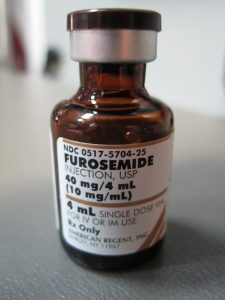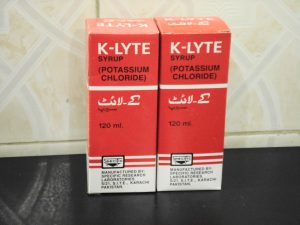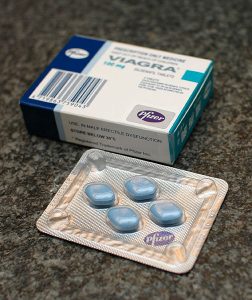2.4 Urinary System Medications
Various categories of medications can be used to treat the urinary pathologies described in the previous section. The medications listed below are some of the more common ones prescribed both in the hospital and in the community for patients with these pathologies. Urinary system medications can also be prescribed to treat disorders of other body systems such as hypertension and congestive heart failure, conditions that occur within the cardiovascular system, which will be described in a later chapter. Hypertension is often treated with a medication that combines a diuretic, which is a urinary system medication, and a medication that directly affects the heart, which would be a cardiovascular medication.
Diuretic Medications
Diuretic medications are often referred to as “water pills.” Most diuretics work by removing sodium, and in turn water, from the body in the form of urine (Mayo Clinic, 2023). Diuretics promote polyuria. They are used to decrease blood pressure and to decrease symptoms of fluid overload when patients have congestive heart failure (CHF) and generalized edema.
There are several categories of diuretics, and a patient’s condition will determine which category of diuretic will be used (Mayo Clinic, 2023). This section will discuss three categories of diuretics: loop, thiazide, and potassium sparing. There are others, but they will not be discussed here.
Loop Diuretic Medications
Loop diuretics inhibit the absorption of sodium and chloride in the loop of Henle and the proximal and distal tubules, causing fluid loss, along with the loss of sodium, potassium, calcium, and magnesium. These diuretics are considered potassium-wasting diuretics because potassium is excreted in the patient’s urine, which can cause hypokalemia. This, in turn, can cause serious issues with the patient’s heart rate (Mayo Clinic, 2023). Patients taking loop diuretic medications are often also prescribed a potassium supplement, which will be discussed later on this page. These diuretics are very potent and are used to treat conditions such as edema, hypertension, and, more specifically, pulmonary edema.

The following are the most common loop diuretics:
- furosemide (Lasix) (Fig. 2.9)
- ethacrynic acid (Edecrin)
(Dr Matt & Dr Mike, 2022)
Thiazide Diuretic Medications
Thiazide diuretics work near the distal tubule to promote the excretion of sodium and water, thus increasing urine output. This category of diuretics is also considered potassium wasting and would likely require a patient to be on a potassium supplement. They are one of the first treatments used for hypertension (Mayo Clinic, 2022).
Some common thiazide diuretics are the following:
- hydrochlorothiazide (HCTZ)
- indapamide (Lozide)
- metolazone (Zaroxolyn)
Key Concept
A common suffix seen with thiazide diuretics is -thiazide.
Example: hydrochlorothiazide
Note: HCTZ is an abbreviation often used for hydrochlorothiazide.
Potassium-Sparing Diuretic Medications
Some diuretic medications are potassium sparing, meaning that they don’t cause the body to lose potassium like loop and thiazide diuretics. This category of diuretics is called potassium-sparing medications. If a patient is on one of the diuretics from the other two categories and their potassium levels are low, there is an option to switch to a potassium-sparing diuretic (Mayo Clinic, 2022). One of the most common potassium-sparing diuretic drugs is called spironolactone or Aldactone (brand name). Spironolactone causes increased amounts of sodium and water to be excreted while potassium is retained. It is used to treat hypertension and to control edema in patients with heart failure or liver dysfunction.
The following are common potassium-sparing diuretics:
- spironolactone (Aldactone)
- amiloride (Midamor)
Key Concept
Loop and thiazide diuretics are potassium-wasting medications and may cause a patient to have seriously low levels of potassium in their blood, or hypokalemia. A physician might first try a diet high in potassium to elevate the patient’s blood potassium levels, and if this is ineffective, the patient will be prescribed potassium chloride (KCL) (Mayo Clinic, 2022).
Potassium chloride medications often have the letter K in their drug name, indicating the chemical element potassium; for examples, see the medications listed in Table 2.2 below. Potassium chloride is measured in milliequivalents (mEq). Patients should have potassium blood levels drawn to ensure that the medication is working for them and that their potassium levels are within the normal range (WebMD, 2023).
Table 2.2. Common Potassium Chloride Medications
| potassium chloride | K-Dur |
| potassium chloride | Klor-Con |
| potassium chloride | Micro-K |
| potassium chloride | K-Lyte (Fig. 2.10) |

(WebMD, 2022)
Medications for Treating Urinary Tract Infections (UTIs)
Fluoroquinolones
Fluoroquinolones are a category of antibiotics used to treat urinary tract infections, but they can be used to treat other infections as well, including pneumonia and complicated skin infections. They are bacteriocidal and take action against the DNA of bacterial cell walls. Many fluoroquinolones are broad spectrum and are effective against a wide variety of both gram-positive and gram-negative bacteria. Levofloxacin (Levaquin) is an example of a common fluoroquinolone used to treat UTIs (WebMD, 2023).
Sulfonamides
Sulfonamides are one of the oldest broad-spectrum antimicrobial agents and work by competitively inhibiting the bacterial metabolic enzymes needed for bacterial function. Sulfonamides are used to treat urinary tract infections, but they are also used to treat otitis media, acute exacerbations of chronic bronchitis, and travellers’ diarrhea. Trimethoprim-sulfamethoxazole (Bactrim and Septra) is a common sulfonamide medication used to treat UTIs.
Other Antibiotics
Other antibiotics are used to treat urinary tract infections and don’t fit into the above categories but are commonly used. Macrobid is a nitrofuran antibiotic and is often prescribed to treat uncomplicated urinary tract infections. Monurol is a broad-spectrum antibiotic, and its primarily use is to treat uncomplicated UTIs as well. Keflex is a cephalosporin antibiotic that can be prescribed to treat various bacterial infections, including UTIs. Anti-infectives will be discussed in more detail in a later chapter (WebMD, 2023).
Cranberries for a UTI, yes or no?

There have been studies on the idea that cranberries, shown in Fig. 2.11, may help cure UTIs (WebMD, 2023). The research indicates that although cranberries don’t work for everyone, they might work as a preventative measure but should not be used to treat a urinary tract infection that someone already has. The reasoning behind cranberries being helpful for preventing UTIs is that they make the urine more acidic so that bacteria cannot grow. Also, cranberries make the urinary tract walls stickier so that bacteria cannot adhere to them, thus creating an unfavourable environment for the bacteria (WebMD, 2023). There are some risks with taking too much cranberry juice, extract, or whole cranberries, including an increased risk of kidney stones and interactions with other medications. It is always important to speak with your physician and pharmacist prior to taking any supplement, including cranberries.
Medications for Treating Overactive Bladder
Muscarinic antagonists, referred to as anticholinergics, is a category of medications used to treat overactive bladder. They inhibit the action of acetylcholine, which causes the smooth muscle in the bladder to relax, and by doing so, decrease bladder contractions and incontinence. Detrol and Ditropan are two common medications used to treat overactive bladder.
Medications for Treating Benign Prostatic Hypertrophy
Alpha1-Receptor Blocker Drugs
Benign prostatic hypertrophy (BPH) presents with symptoms of hesitancy to urinate and a lower-than-normal urinary stream owing to an enlarged prostate gland compressing the urethra. Tamsulosin selectively blocks alpha receptors in the prostate, allowing the smooth muscles in the bladder, neck, and prostate to relax, and thus improving urine flow and reducing the symptoms of BPH.
Key Concept
A common suffix seen with alpha1-receptor blocker drugs is -losin.
Example: tamsulosin (Flomax)
5-Alpha-Reductase Inhibitors
This category of medications is also used to treat the symptoms of BPH, but it has additional actions in that it halts the growth of the prostate if taken regularly as prescribed. An example of a 5-alpha-reductase inhibitor is finasteride (Proscar) (WebMD, 2023).
Medications for Erectile Dysfunction
Phosphodiesterase (PDE-5) Inhibitor Drugs
Sildenafil (Viagra) is commonly known to treat erectile dysfunction (ED) (see Fig. 2.12 for an image of Viagra). This medication is taken orally in the form of a tablet. It inhibits phosphodiesterase (PDE-5) in the pulmonary smooth muscle and corpus cavernosum, allowing the smooth muscle to relax and the corpus cavernosum to dilate, facilitating erection. This medication was originally developed to treat pulmonary hypertension, but it has been found to be useful for other conditions, including ED. However, it must be used with caution in patients with decreased hepatic, renal, and cardiac functions. One possible side effect is prolonged priapism that lasts longer than four hours. If this occurs, the patient should seek medical attention.

Tadalafil (Cialis) is another medication that inhibits phosphodiesterase (PDE-5) and is used for ED. It can also be used to treat benign prostatic hyperplasia (BPH) because it decreases inflammation in the prostate (WebMD, 2023). This medication must be used with caution in patients with cardiac conditions such as recent myocardial infarction and in those with uncontrolled arrhythmias (WebMD, 2023) .
Table 2.3. Common Urinary System Medications
| Generic Name | Trade Name | Reason for Administering |
| furosemide | Lasix | HTN, CHF, edema |
| ethacrynic acid | Edecrin | HTN, CHF, edema |
| hydrochlorothiazide | HCTZ | HTN, CHF, edema |
| indapamide | Lozide | HTN, CHF, edema |
| metolazone | Zaroxolyn | HTN, CHF, edema |
| spironolactone | Aldactone | HTN, CHF, edema |
| amiloride | Midamor | HTN, CHF, edema |
| levofloxacin | Levaquin | UTI |
| trimethoprim-sulfamethoxazole | Bactrim, Septra | UTI |
| nitrofurantoin | Macrobid | UTI |
| fosfomycin | Monurol | UTI |
| cephalexin | Keflex | UTI |
| tolterodine | Detrol | Overactive bladder |
| oxybutynin | Ditropan | Overactive bladder |
| finasteride | Proscar | BPH |
| sildenafil | Viagra | Erectile dysfunction |
| tadalafil | Cialis | Erectile dysfunction |
(WebMD, 2023)
Attribution
Unless otherwise indicated, material on this page has been adapted from the following resource:
Ernstmeyer, K., & Christman, E. (Eds.). (2020). Nursing pharmacology. Chippewa Valley Technical College. https://wtcs.pressbooks.pub/pharmacology/, licensed under CC BY 4.0
References
Dr Matt & Dr Mike. (2022, February 22). Loop diuretics in 2 minutes! [Video]. YouTube. https://www.youtube.com/watch?v=THqDmN4HcM8
Mayo Clinic. (2023). Diuretics. https://www.mayoclinic.org/diseases-conditions/high-blood-pressure/in-depth/diuretics/art-20048129#:~:text=Diuretics%2C%20sometimes%20called%20water%20pills,through%20your%20veins%20and%20arteries
Mayo Clinic. (2022). Diuretics: A cause of low potassium? https://www.mayoclinic.org/diseases-conditions/high-blood-pressure/expert-answers/blood-pressure/faq-20058432#:~:text=Diuretics%20are%20commonly%20used%20to,in%20the%20blood%20(hypokalemia)
WebMD. (2023). Drugs & medications A-Z. https://www.webmd.com/drugs/2/index
Image Credits (images are listed in order of appearance)
Furosemide (1) by Intropin, CC BY 3.0
K-Lyte (Potassium Suplement) by Miansari66, CC0 1.0 Universal
Cooking cranberries in El Paso by Susan Barnum, CC BY-SA 4.0
Viagra in Pack by SElefant, CC BY-SA 3.0
urinating more than usual or producing an abnormal amount of urine
swelling in the body, often in the lower limbs
low potassium levels
high blood pressure
excess fluid in the lungs
antibiotics that kill bacteria
antibiotics that work for many types of bacterial infections
prolonged erection of the penis

